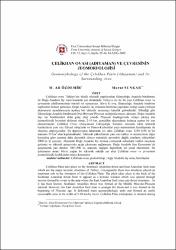Çelikhan Ovası (Adıyaman) ve Çevresinin Jeomorfolojisi
Citation
Özdemir, M. A., Sunkar, M. (2002). Çelikhan Ovası (Adıyaman) ve Çevresinin Jeomorfolojisi. Fırat Üniversitesi Sosyal Bilimler Dergisi, 12 (1), 25-46Abstract
Çelikhan ovası Türkiye’nin büyük tektonik yapılarından Güneydoğu Anadolu bindirmesi ile Doğu Anadolu fay zonu üzerinde yer almaktadır. Dolayısı ile bu iki yapı Çelikhan ovası ve çevresinin şekillenmesinde önemli rol oynamıştır. Şöyle ki ova, Güneydoğu Anadolu bindirme cephesinin hemen gerisinde, Doğu Anadolu fay zonunun bindirme yapılarını kestiği alana yerleşen akarsuların aşındırmasıyla açılmış bir tektonik pencereye karşılık gelmektedir. Bilindiği gibi Güneydoğu Anadolu bindirmesi Orta Miyosen-Pliyosen aralığında ortaya çıkmıştır. Doğu Anadolu fayı ise bindirmeden daha genç olup yörede Pliyosen başlangıcında ortaya çıkmış ana jeomorfolojik birimleri deforme etmiş, 2-10 km. genişlikte akarsularca kolayca aşınan bir zon oluşturmuştur. Çelikhan Ovası (Adıyaman) Güneydoğu Toroslar arasında etkin tektonik hareketlerin yanı sıra flüvyal süreçlerin ve Permo-Karbonifer yaşlı mermerlerin karstlaşması ile oluşmuş depresyondur. Bu depresyonun tabanında yer alan Çelikhan ovası 1250-1350 m.’ler arasında 15 km2 alan kaplamaktadır. Tektonik yükselmenin yanı sıra kalker ve mermerlerin diğer kayaçlara göre aşınıma daha dayanıklı olması nedeniyle çevredeki dağlık alanların yükseltileri 2000 m.’yi aşmıştır. Akarsular Doğu Anadolu fay zonuna yerleşerek subsekant vadiler meydana getirmiş ve tektonik pencerenin açığa çıkmasını sağlamıştır. Doğu Anadolu fayı Kuvaterner’de gençleşerek yan dereleri 300-1500 m. arasında değişen değerlerde sol yanal ötelemiştir. Bu çalışmanın amacı böyle yoğun bir tektonik sahada yer alan Çelikhan ovası ve çevresinin jeomorfolojik özelliklerini ortaya koymaktır. Çelikhan Plain take place on the Southeast Anatolian thrust and East Anatolian fault zone which are the major tectonic structures of Turkey. Consequently these two structures played an important role in the formation of the Çelikhan Plain. The plain takes place in the back of the Southeast Anatolian thrust front. It appears as a tectonic window which was opened through erosion formed by rivers in the area where the East Anatolian fault zone cuts thrust structures . As it has been known, Southeast Anatolian thrust was formed at the Middle Miocene-Pliocene internal. However, the East Anatolian fault zone is younger the thrust and it was formed at the beginning of Pliocene age. It deformed main geomorphologic units and formed an easily erosionable zone in the width of 2-10 km by rivers. Çelikhan Plain (Adıyaman) is situated among ranges of the Southeastern Taurus mountains. It is a depression which was formed with the effects of tectonic movements, fluvial processes, karstification of marbles aged Permo-Carboniferous. Çelikhan plain situated at the bottom of this depresion is covered an area of 15 km2 at the surface elevation of 1250 m and 1350 m. This depression bottom an area of 15 km2 at the surface elavation of 1250 and 1350 m. By the side of uplift due to tectonic. Limestone and marbles which have more strength than the other stone toward erosion, were formed mountainous areas higher than 2000 m. in the surrounding area. After the rivers settled in the East Anatolian fault zone, they formed subsequent valleys and caused formation of the tectonic window. The East Anatolian fault rejuvenated Quaternary and its side rivers took left lateral offset at changing degrees between 300 and 1500 m. This study aims to explain geomorphologic characteristics of the Çelikhan plain and its surroundings which lies in such a heavy tectonic area.
Source
Fırat Üniversitesi Sosyal Bilimler DergisiVolume
12Issue
12Collections
- Makaleler [38]



















